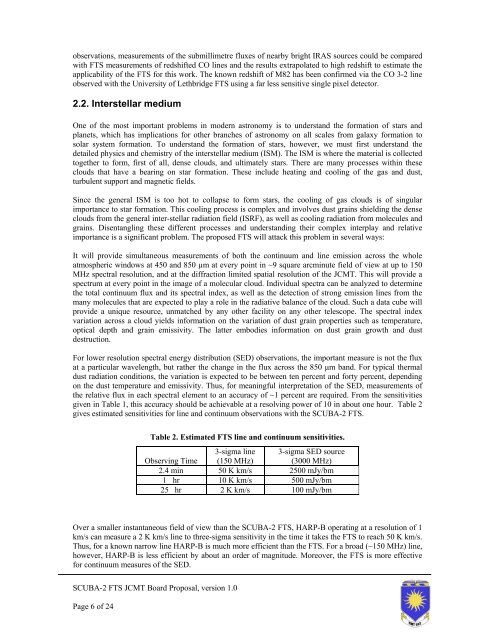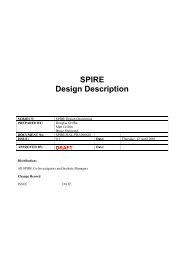Proposal - Research Services - University of Lethbridge
Proposal - Research Services - University of Lethbridge
Proposal - Research Services - University of Lethbridge
You also want an ePaper? Increase the reach of your titles
YUMPU automatically turns print PDFs into web optimized ePapers that Google loves.
observations, measurements <strong>of</strong> the submillimetre fluxes <strong>of</strong> nearby bright IRAS sources could be compared<br />
with FTS measurements <strong>of</strong> redshifted CO lines and the results extrapolated to high redshift to estimate the<br />
applicability <strong>of</strong> the FTS for this work. The known redshift <strong>of</strong> M82 has been confirmed via the CO 3-2 line<br />
observed with the <strong>University</strong> <strong>of</strong> <strong>Lethbridge</strong> FTS using a far less sensitive single pixel detector.<br />
2.2. Interstellar medium<br />
One <strong>of</strong> the most important problems in modern astronomy is to understand the formation <strong>of</strong> stars and<br />
planets, which has implications for other branches <strong>of</strong> astronomy on all scales from galaxy formation to<br />
solar system formation. To understand the formation <strong>of</strong> stars, however, we must first understand the<br />
detailed physics and chemistry <strong>of</strong> the interstellar medium (ISM). The ISM is where the material is collected<br />
together to form, first <strong>of</strong> all, dense clouds, and ultimately stars. There are many processes within these<br />
clouds that have a bearing on star formation. These include heating and cooling <strong>of</strong> the gas and dust,<br />
turbulent support and magnetic fields.<br />
Since the general ISM is too hot to collapse to form stars, the cooling <strong>of</strong> gas clouds is <strong>of</strong> singular<br />
importance to star formation. This cooling process is complex and involves dust grains shielding the dense<br />
clouds from the general inter-stellar radiation field (ISRF), as well as cooling radiation from molecules and<br />
grains. Disentangling these different processes and understanding their complex interplay and relative<br />
importance is a significant problem. The proposed FTS will attack this problem in several ways:<br />
It will provide simultaneous measurements <strong>of</strong> both the continuum and line emission across the whole<br />
atmospheric windows at 450 and 850 µm at every point in ~9 square arcminute field <strong>of</strong> view at up to 150<br />
MHz spectral resolution, and at the diffraction limited spatial resolution <strong>of</strong> the JCMT. This will provide a<br />
spectrum at every point in the image <strong>of</strong> a molecular cloud. Individual spectra can be analyzed to determine<br />
the total continuum flux and its spectral index, as well as the detection <strong>of</strong> strong emission lines from the<br />
many molecules that are expected to play a role in the radiative balance <strong>of</strong> the cloud. Such a data cube will<br />
provide a unique resource, unmatched by any other facility on any other telescope. The spectral index<br />
variation across a cloud yields information on the variation <strong>of</strong> dust grain properties such as temperature,<br />
optical depth and grain emissivity. The latter embodies information on dust grain growth and dust<br />
destruction.<br />
For lower resolution spectral energy distribution (SED) observations, the important measure is not the flux<br />
at a particular wavelength, but rather the change in the flux across the 850 µm band. For typical thermal<br />
dust radiation conditions, the variation is expected to be between ten percent and forty percent, depending<br />
on the dust temperature and emissivity. Thus, for meaningful interpretation <strong>of</strong> the SED, measurements <strong>of</strong><br />
the relative flux in each spectral element to an accuracy <strong>of</strong> ~1 percent are required. From the sensitivities<br />
given in Table 1, this accuracy should be achievable at a resolving power <strong>of</strong> 10 in about one hour. Table 2<br />
gives estimated sensitivities for line and continuum observations with the SCUBA-2 FTS.<br />
Table 2. Estimated FTS line and continuum sensitivities.<br />
3-sigma line 3-sigma SED source<br />
Observing Time (150 MHz) (3000 MHz)<br />
2.4 min 50 K km/s 2500 mJy/bm<br />
1 hr 10 K km/s 500 mJy/bm<br />
25 hr 2 K km/s 100 mJy/bm<br />
Over a smaller instantaneous field <strong>of</strong> view than the SCUBA-2 FTS, HARP-B operating at a resolution <strong>of</strong> 1<br />
km/s can measure a 2 K km/s line to three-sigma sensitivity in the time it takes the FTS to reach 50 K km/s.<br />
Thus, for a known narrow line HARP-B is much more efficient than the FTS. For a broad (~150 MHz) line,<br />
however, HARP-B is less efficient by about an order <strong>of</strong> magnitude. Moreover, the FTS is more effective<br />
for continuum measures <strong>of</strong> the SED.<br />
SCUBA-2 FTS JCMT Board <strong>Proposal</strong>, version 1.0<br />
Page 6 <strong>of</strong> 24
















